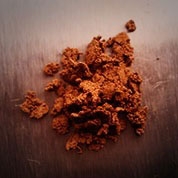MDAI

Pharmacology
Methylenedioxy-2-aminoindane (MDAI) is a drug originally synthesised by the American pharmacologist and medicinal chemist, David E. Nichols during the 1990s at Purdue University. Ordinarily, it appears as a tan-coloured, crystalline powder.
MDAI is derived from the drug -3, 4-methylenedioxyamphetamine (MDA) –a single structural alteration is the only difference between the two drugs. However, due to this structural change occurring in the region responsible for typical amphetamine-like responses, significant pharmacological differences are seen when comparing MDAI with MDA.
MDAI has been shown to strongly stimulate the release of the neurotransmitter serotonin in research models and can therefore be described as being a ‘selective serotonin releasing agent’ (SSRA). Serotonin (or 5-HT), is mainly found in the intestines and central nervous system where it is involved in the regulation of processes such as: intestinal movement, sleep, mood, appetite, memory and learning.
The extent to which MDAI stimulates serotonin release is comparable to that seen with MDA but less than is seen with 3, 4-methylenedioxy-N-methylamphetamine (MDMA).
In humans, MDAI has been shown to produce heightened feelings of empathy, love and emotional closeness with others. Drugs producing these effects are known as entactogens (or empathogens) and in addition to MDAI, include MDMA and related ‘MDxx’ drugs.
In contrast to many similar drugs, MDAI has been found to be largely non-stimulating and has so far proven to cause neurotoxicity when taken by without any other drugs. Reliable data concerning toxic effects on the heart (a known problem with many amphetamine and amphetamine-like drugs) has yet to be gathered for MDAI.
MDAI has also been found to inhibit the reuptake (movement back into cells) of serotonin as well as (to a lesser degree) the neurotransmitters dopamine (involved in regulating reward-seeking behaviour) and norepinephrine (or noradrenaline –a primary stress hormone).
Subjective user reports have indicated that mild pharmacological effects are seen at doses between 150mg-250mg, with significant effects above this. However, factors such as a user’s weight, previous usage and metabolism are just some variables that would determine an individual’s response to MDAI.
Adulteration with other drugs (including the now illegal drug mephedrone), has been found in samples being sold as MDAI and this could also significantly alter the pharmacological and toxic effects produced.
